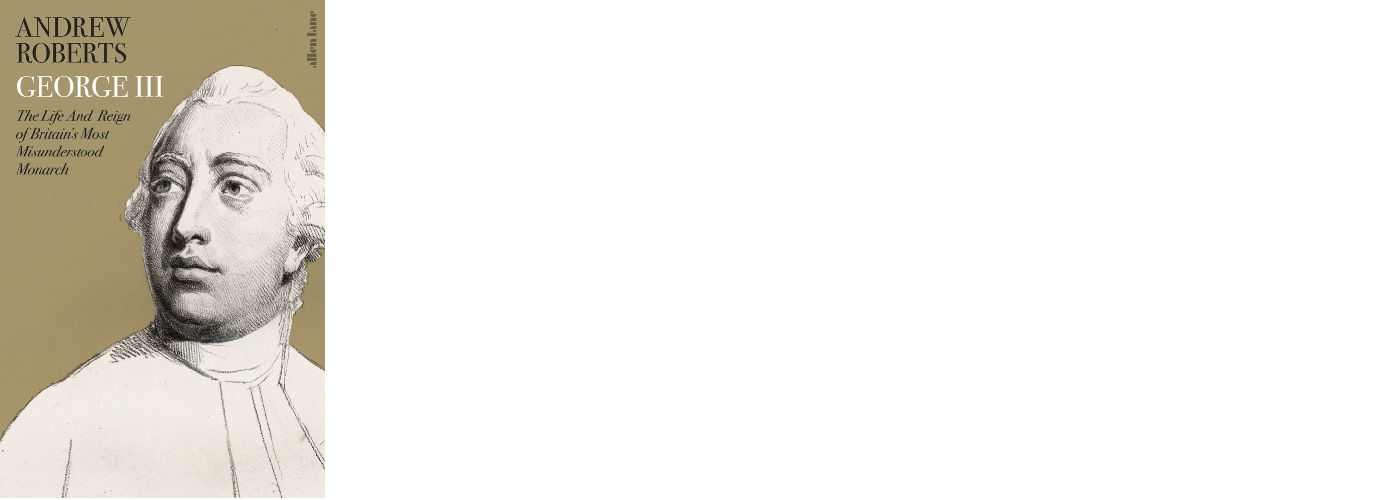Book of the week: George III by Andrew Roberts
In this mammoth and meticulous biography, Roberts presents a compelling case for the defence of King George III

Posterity hasn’t been kind to “poor” King George III, said Dominic Sandbrook in The Sunday Times. In Britain, he is remembered either as the “blundering oaf whose insensitivity lost the American colonies”, or as the “mad king” who once mistook an oak tree for the king of Prussia. In the US, he continues to be seen as the “cruel tyrant” whose tax demands drove the colonists to rebellion.
Yet in this mammoth and meticulous biography, Andrew Roberts presents a compelling case for the defence. George, he insists, was not remotely tyrannical; he was “well-meaning, hard-working, decent, dutiful, moral, cultured and kind”. If anything, he was slightly boring – he had no obvious vices (he rarely drank and was never unfaithful) and his “idea of fun was writing an article about farming”.
As for George’s mental health, Roberts has no truck with the common idea that his late-life insanity was caused by porphyria (a genetic blood disease). Instead, he thinks bipolar disorder was to blame.
Subscribe to The Week
Escape your echo chamber. Get the facts behind the news, plus analysis from multiple perspectives.

Sign up for The Week's Free Newsletters
From our morning news briefing to a weekly Good News Newsletter, get the best of The Week delivered directly to your inbox.
From our morning news briefing to a weekly Good News Newsletter, get the best of The Week delivered directly to your inbox.
Over the nearly 60 years of his reign (he ascended to the throne aged 22 in 1760), George III “did much to shape the monarchy as it is known today”, said Ruth Scurr in The Times. He purchased Buckingham House (now Palace); bought almost half the present Royal Collection of art; and configured the monarch’s “constitutional role in terms of duty, piety and virtue”.
The denigration of his character began early, and was carried out initially by his opponents in the “Old Whig” faction, which had dominated British politics since the Glorious Revolution. Never forgiving the king for opposing their hegemony, they sniped incessantly from the sidelines – the Whig historian Horace Walpole even cattily said of George’s choice of bride, Charlotte of Mecklenburg-Strelitz, that her “bloom of ugliness” started fading at 17.
The “big event” of George’s reign was, of course, America’s secession, said Tim Blanning in Literary Review. Roberts devotes around half his book to the topic. The War of Independence did not, he suggests, have much to do with taxation – the average American paid little tax, and it stayed in America. Rather, it was a question of “sovereignty, independence and self-government”. And it suited the colonists to portray themselves as victims of a “despotic tyrant”: that way they could “justify their illegal secession”.
This is not an account of American liberation that will recommend itself to patriotic American readers, but it’s bracing and “masterly”. With the publication of this superb biography, the rehabilitation of King George III has “come at last”.
Allen Lane 784pp £35; The Week Bookshop £27.99 (incl. p&p)

The Week Bookshop
To order this title or any other book in print, visit theweekbookshop.co.uk, or speak to a bookseller on 020-3176 3835. Opening times: Monday to Saturday 9am-5.30pm and Sunday 10am-4pm.
Sign up for Today's Best Articles in your inbox
A free daily email with the biggest news stories of the day – and the best features from TheWeek.com
-
 May 26 editorial cartoons
May 26 editorial cartoonsCartoons Monday's political cartoons feature Donald Trump's red tie, Hunter Biden's crypto lament, and one meaning of Memorial Day
-
 3 tips for coping with financial stress
3 tips for coping with financial stressThe explainer Feel more at peace in an unpredictable economy
-
 Crossword: May 26, 2025
Crossword: May 26, 2025The Week's daily crossword
-
 The cinematic beauty of Sicily's Aeolian Islands
The cinematic beauty of Sicily's Aeolian IslandsThe Week Recommends These scattered islands have inspired film directors since the 1950s
-
 6 lounge-ready homes with conversation pits
6 lounge-ready homes with conversation pitsFeature Featuring a terrazzo-flanked pit in California and a fire-side pit in Nevada
-
 Is a River Alive?: a 'powerful synthesis of literature, activism and ethics'
Is a River Alive?: a 'powerful synthesis of literature, activism and ethics'The Week Recommends Robert Macfarlane's latest book centres on his journeys to four river systems around the world
-
 Good One: an 'intensely compelling' coming-of-age tale
Good One: an 'intensely compelling' coming-of-age taleThe Week Recommends India Donaldson's 'quietly devastating' debut feature about a teenage girl's life-changing camping trip
-
 The best lemon pepper wings in Atlanta
The best lemon pepper wings in AtlantaFeature Marinated turkey wings, a Korean barbecue sauce combo and an off-menu staple
-
 Film reviews: Friendship and Fight or Flight
Film reviews: Friendship and Fight or FlightFeature An awkward dad unravels after he's unfriended and Josh Hartnett attempts a John Wick sidestep
-
 Art review: Ai, Rebel: The Art and Activism of Ai Weiwei
Art review: Ai, Rebel: The Art and Activism of Ai WeiweiFeature Seattle Art Museum, through Sept. 7
-
 Book reviews: 'Second Life: Having a Child in the Digital Age' and 'Mark Twain'
Book reviews: 'Second Life: Having a Child in the Digital Age' and 'Mark Twain'Feature Navigating pregnancy in the digital age and an exploration of Mark Twain's private life